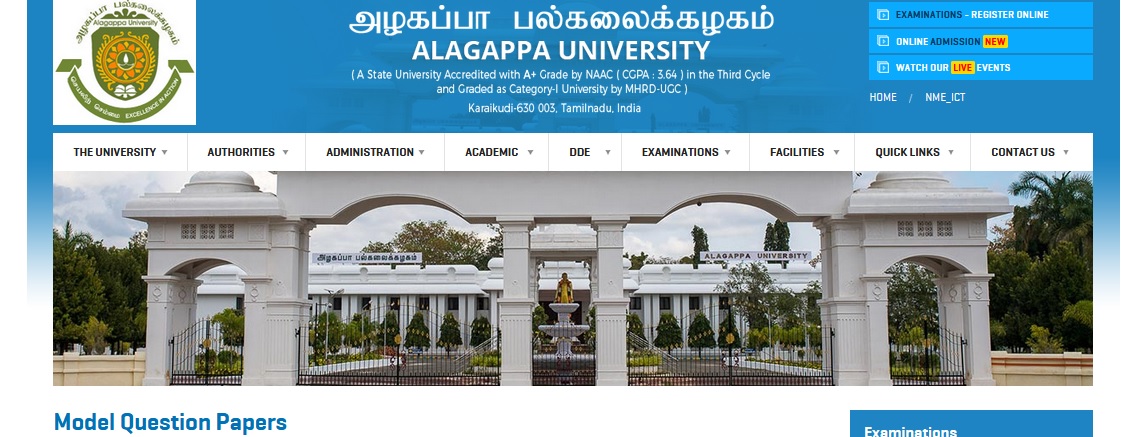Aquaculture And Fisheries Management M.Sc Model Question Papers : alagappauniversity.ac.in
Name of the University : Alagappa University
Degree : M.Sc
Department : Zoology
Subject Code/Name : Aquaculture And Fisheries Management
Document Type : Model Question Papers
Website : alagappauniversity.ac.in
Download Model/Sample Question Paper : http://alagappauniversity.ac.in/
Alagappa University Aquaculture Question Paper
M.Sc. DEGREE EXAMINATION, NOVEMBER 2010
Part – A (10 × 2 = 20)
1. Trawl net.
Related / Similar Question Paper :
Alagappa University Animal Health Policy M.Sc Question Papers
2. Epizootic Ulcerative Syndrome.
3. Exotic species.
4. Bio-invasion.
5. Coastal Regulation Zone.
6. In-vitro.
7. Brooder.
8. Penaeus monodon.
9. WSSV.
10. MSY.
11. (a) Discuss any two important water quality
(b) Write note on the impact of marine pollution on fisheries.
3 RW-6062
12. (a) Describe the exotic species aquaculture and
(b) Write note on ex-situ conservation with an example.
13. (a) Explain the role of fish aggregating devices
(b) Write short note on peoples’ participated
14. (a) Explain the duties of Coastal aquaculture
(b) Write short note on the effect aquaculture
15. (a) Describe the dif ferent co-management

(b) Discuss the two viral diseases of fin and shell
16. Explain the density based different types of shrimp
17. Write an essay on post harvest technologies in
18. Describe the impact of invasive species on aquatic
19. Write an essay on recent concepts in fisheries
20. Describe the different molecular techniques in
M.Sc., DEGREE EXAMINATION, NOVEMBER 2010
ECONOMICS & ANIMAL HEALTH
Answer all questions.
1. Define Economic Theory.
2. Demand Analysis.
3. Price Discrimination.
4. Cost Volume.
5. Production analysis.
6. Animal Health Management.
7. Investment Analysis.
8. Profit Maximization output level.
9. Optimization through diversification.
10. Health Service.
11 (a) Explain about the animal Health Business analysis.
(b) Define the application of Economic theory.
12. (a) Illustrate the Demand elasticity. Add notes
(b) Write a short note on supply analysis on
13 (a) Discuss the role of consumer market structure.
(b) Explain a simple measure of long-term
14 (a) Describe in detail about the role of
(b) Write the Principle and Applications on
15 (a) Write notes on Profit maximization output level.
(b) Discuss the functions and tools of Animal
16. Describe in detai l about Animal Health
17. Discuss about consumer surplus and their
18. Write an account on R and D cost. Add notes on
19. Write notes on Profit Goals, Planning and
20. Explain about Investment analysis in Health Clinic.
M.Sc. DEGREE EXAMINATION, NOVEMBER 2010
ANIMAL PRODUCTION SYSTEMS
Part – A (10 × 2 = 20)
1. Backyard farming.
2. Integration.
3. Manure Pit.
4. Incinerator.
2 RW-6064
5. Construction Co-efficient.
6. Attic Insulation.
7. Over hang.
8. Solar energy.
9. Marketing Potential.
10. Four “P”s.
11. (a) Describe All – in – All out system.
(b) Environmentally controlled house.
12. (a) Differentiate between vertical and horizontal.
(b) Discuss in details about mixed farming system.
13. (a) Wintter management of livestock.
(b) Loose house.
14. (a) Certified Organic foods.
(b) Utilization of Wind energy.
15. (a) Types of marketing Channels.
(b) Discuss the pricing strategies for Animal Products.
Fisheries & Aquaculture
Distance Education :
M.Sc. (Zoology) Degree Examination, December 2015.
Time : Three hours Maximum : 100 marks
Section A :
Answer any FIVE questions.
All questions carry equal marks.
1. Classify any five economically important marine fishes of Indian coasts.
2. How would you determine the age of a fish?
3. Enumerate the role of hormones in fish reproduction.
4. Discuss the migration in fishes.
5. What are the site selection criteria for aquaculture ponds?
6. Give an account of Pearl Oyster culture.
7. Briefly explain the common finfish and shellfish diseases and their control.
8. What is meant by ‘cryopreservation’? Mention its uses.
Section B : (4 × 15 = 60 Marks)
Answer any FOUR questions.
All questions carry equal marks.
9. Discuss the types of gear and crafts used for fish capture.
10. Explain the growth, feeding adaptations and reproductive behaviour of the Indian major carps.
11. Describe the live feed culture and its techniques.
12. Describe the control of physio-chemical factors in management of fish farm.
13. Give an account of method of artificial breeding of fishes.
14. Enumerate the economic importance of composite fish culture.
15. How will you examine the freshness of fish? Briefly explain.
What happens to dissolved oxygen when salinity increase?